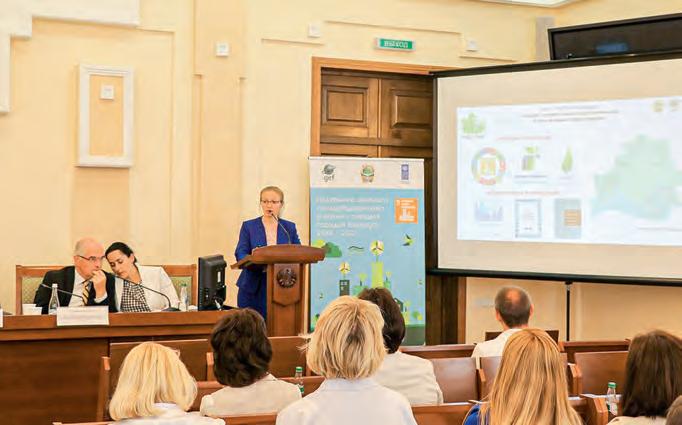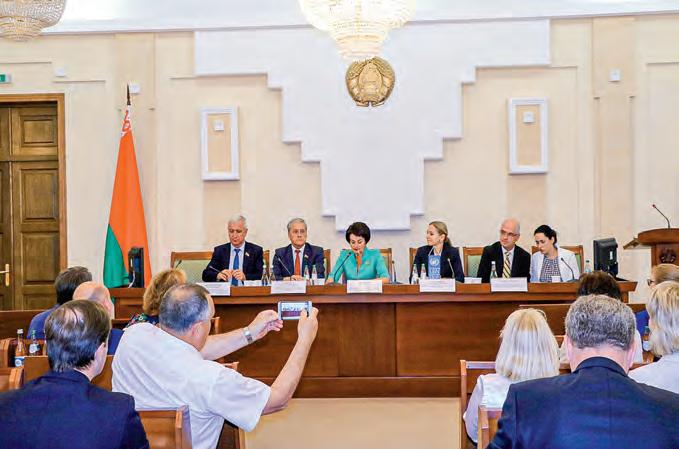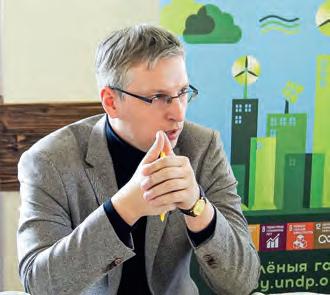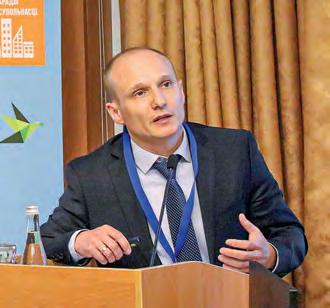
12 minute read
Legislative environment for innovation
It is worth recalling that the project “Green Cities”, funded by the Global Environment Facility and implemented by UNDP together with the Ministry of Natural Resources and Environmental Protection of Belarus, is aimed at the improvement of the infrastructure of pilot cities to reduce greenhouse gas emissions. This is the type of activities that receive the major part of the Project budget. However, in order to ensure that innovations in urban development are widely applied in the country, the Project is working to create systemic conditions in which the introduction of green urban planning principles for designers and all those involved in urban environment planning would become a routine daily practice under the law.
legislative environment for innovation
Advertisement
It should be noted that the Project has a separate component that focuses on the improvement of existing legislation in the area of urban planning. Specifically, the experts were tasked with developing proposals in the areas of urban transport, sustainable urban mobility, and street lighting. — When the experts immersed themselves in these topics and studied the experience of the countries that are leaders in green development, it became clear that it would not be possible to limit the narrow scope of legislation in these areas,— explains Vera Sysoeva, architect, expert of the Project for Green Urban Development.— International experience, recommendations of UN-HABITAT (United Nations Human Settlements Programme) insist on the need for an integrated approach to legislation formation for urban sustainable development.
Vera Sysoeva says that Belarus is not a first-timer in creating a system, such as, for example, technical regulation in urban
Vera Sysoeva
planning. Much of what is in force today is still a legacy from Soviet times, when legal regulation of urban development was aimed at restoring industrial enterprises and cities destroyed by the war, and at developing, in particular, mass capital construction. Today, the regulatory legal framework is adapted to a large extent to market economy conditions. In other words, it has been updated for various participants in the urban planning process. At the same time, one cannot neglect the fact that the role of the state in the planning and management process has increased as well.
In order to streamline the requirements of technical regulations in the area of architecture and urban planning, Belarus has recently been reforming its entire system of building regulations. This means that the practice of “Green Cities” has successfully coincided with the creation of new documents and audits of the existing ones.
However, urban planning legislation is also closely linked to other legal documents in force in Belarus: for example, the laws on local government and self-government, on environmental protection, on energy saving, and many others.
There are also more global agreements and strategies that define the direction the country is taking in terms of urban development. These include, in particular, the “Concept of the National Sustainable Development Strategy of the Republic of Belarus” and the system of State Urban Policy documents, which are updated every five years. — The year 2020 is the final in a five- year period, and we expect the formation of urban policy for a new stage,— says
expert Vera Sysoeva.— Strategic documents set priorities in the area of urban planning, and this policy is already being implemented through a system of legal regulation.
everything for sustainable development
The proposals on legislative optimization prepared by the Green Cities project can be divided into four blocks. Firstly, these are proposals for strategic documents that form the agenda of sustainable urban development, and for the Code of the Republic of Belarus “On Architectural, Urban Planning and Construction Activities”. This is followed by three quite equivalent groups of documents: technical regulations in the area of urban planning, traffic management regulations and street lighting regulations.
The project “Green Cities” included the best foreign experience in the “Concept of the National Sustainable Development Strategy of the Republic of Belarus until 2035”, in its sections devoted to regional and urban development. The project proposals were aimed at strengthening the role of the city for sustainable development, providing it with the appropriate tools and resources. The need for local government, development of city institutions and urban community was emphasized, and tools that can be used for this were proposed, i.e. indicators, urban strategies. Proposals were put forward to the National Strategy to strengthen the rights and opportunities for people with disabilities, as well as those that provide targeted support in general for all categories of citizens. For example, not only families with many children, but also families with children in general.
A large block of proposals was focused on environmental protection. This is one of the main development goals that cannot be ignored due to limited budgets and must be taken into account when making decisions. As regards the Code of the Republic of Belarus “On Architectural, Urban Planning and Construction Activities”, “Green Cities”, along with many other projects,
“Green Cities” offer insight into the principles of green urban development

representatives of the public took part in the discussion of the document and also sent its proposals.
According to Vera Sysoeva, the draft Code, which was presented for discussion, caused many questions. For example, the proposed Code did not specify the goals for which all urban planning laws are being developed, the term “sustainable urban development” was not introduced, and such relevant concepts as mixed development and compact development were not introduced. In fact, everything remained in the realities of extensive “urban development” aimed at building as much and as cheaply as possible. The fact that it is possible to build more efficiently, with certain social goals, with an environmental priority was not mentioned in the initial version of the Code. This is why the document is currently undergoing further development and a new stage of approval. — We must assume that the presentation of the new version of the Code will take place not in the format of information, but also in the format of discussion,— says Vera Sysoeva.— We are ready to provide expert support to this most important regulatory document in the future, if any topics need to be improved.
The next block of Green Cities’ urban development proposals concerns building codes. In the opinion of experts, these norms and regulations must be compact and binding, as it is impossible to ensure safe living without them. — The rest includes voluntary for application rules: vision, wishes, recommendations,— explains Vera Sysoeva.— This is a best practice framework that is recommended for implementation in agreement with the customer.
“Green Cities” sought to introduce the principles of green urban planning into those building codes that describe the requirements for projects developed by design organizations. Proposals were grouped into three themes and were based on the principles of a complex, integrated approach and transparent decision-making to ensure sustainable urbanization and the quality of urban spaces. “Green Cities” advocated the integration of the strategic approach into urban planning projects of general, detailed and specific planning. The project’s experts specified what baseline data could ensure this approach and regulations for harmonization. It is assumed that building regulations will primarily be based on local city plans and programmes, which should be taken into account on an equal footing with regional and national ones. In particular, such local plans and strategies may include both Green City Plans and Sustainable Urban Mobility Plans — anything that the city considers important for sustainable development.
at the meeting with deputies of the House of Representatives of the National assembly of the Republic of Belarus

Set of specific solutions
In another block, proposals were made to improve environmental and socio-economic sustainability. In particular, to ensure the protection of urban areas and facilities as a result of climate change risks. Today, these proposals are also applicable to respond to the pandemic situation. It is important for the environmental and socio-economic development issues not to be less important than the immediate tasks of budget saving.
Recommendations on promoting resource efficiency and reducing greenhouse gas emissions were also presented. Based on the experience gained, thanks to the work of experts, the Project already has a set of specific solutions for reducing greenhouse gas emissions. For example, the focus has been on the priority of environmental mobility and the development of pedestrian and bicycle infrastructure. It was proposed that, for urban planning regulations, it should be possible to set maximum amounts of engineering resources to be consumed so that the city could manage its energy consumption and thus reduce emissions and achieve the goals set by the Covenant of Mayors for Climate and Energy.
In general, it is expected that key performance indicators of green urban development, such as population density, compactness of buildings and their energy consumption, should be included in the justification of project decisions. All this is being done to find the tools to monitor the stage of project selection and then the effectiveness of projects based on their stated objectives. — If the efficiency of a project is monitored only in terms of the number of square metres, without taking into account environmental and many other factors, it is certainly not right,— says Vera Sysoeva.
Another important document is the construction regulations “Planning and development of settlements”. These are the rules for the development of all residential areas except Minsk. The project “Green Cities” put forward detailed proposals for the layout of street and road network, in particular, the organization of parking spaces, as well as resource consumption and adaptation to climate change. The project also proposed actual changes in terminology. It was pointed out that it was necessary to take into account local programmes, strategies, feasibility studies, which may be important conditions for planning and building a settlement.
In preparing the recommendations, suggestions from architects who work with the project “Green Cities” were taken into account. In particular, the architects of such companies as Level80 and MLA+ pointed to the barriers to the introduction of modern design approaches which existing regulations contain, e.g. strict rationing of school grounds, barriers to barrierfree access to residential buildings, and a limited list of permitted coverings. The Project used all these comments in preparing its proposals.
key indicators of success
In the area of energy efficiency improvement, the main areas of activity of the project “Green Cities” are the implementation of pilot energy-saving measures in accordance with best practices, as well as the creation of mechanisms to replicate their results. — As part of the project “Green Cities”, emphasis is placed on modernizing street lighting systems, as well as on introducing smart metering systems for energy resources at Novogrudok housing facilities,— says Ivan Filyutich, expert of the Energy Efficiency Project.— The practical results of these proposals have been reflected in the Action Plans for Sustainable Energy Development and Climate in other municipalities of Belarus under development, as well as in the planning of regional and sectoral energy efficiency programmes in the country.
In addition, a great deal of attention is now being paid by experts to the introduction of sustainable instruments for financing energy efficiency projects in the country. To this end, “Green Cities” has developed recommendations to improve energy service mechanisms in Belarus, which have been taken as a basis for developing the Concept of Development of Energy Service Activities in the country.
Project experts have also developed detailed guidelines on instruments for financing energy saving measures available to Belarusian municipalities. — This document is intended to provide clear and comprehensible guidance to city administrations what foreign sources of financing they can use, and what requirements of international financial insti-
Ivan Filyutich

tutions exist for project parameters,— Ivan Filyutich stresses.
An important element of green urban development is the introduction of sustainable urban mobility principles in settlements, where priority is given to public transport, its low-carbon types, bicycles and pedestrians rather than cars. For example, in 2019 a draft resolution of the Council of Ministers of the Republic of Belarus “On Approval of Methodological Recommendations on the Composition, Procedure for Development, Coordination, Approval, Implementation, Monitoring and Adjustment of the Sustainable Urban Mobility Plan” was prepared. — The methodological recommendations prepared by the project “Green Cities” establish the procedure for development, approval, implementation, monitoring and adjustment of a sustainable urban mobility plan,— explains Dmitry Navoy, expert of the Sustainable Urban Mobility Project.— The document is innovative for Belarus and will allow cities to use resources more efficiently in managing transport and road infrastructure.
everything is going according to plan
The Project also developed proposals to the Law “On Road Traffic”, which, among other things, envisage traffic management using smart transport systems and sustainable mobility plans. With these and other “Green Cities” proposals, the draft Law “On Road Traffic” has already passed its first reading in the House of Representatives of the National Assembly of the Republic of Belarus. As part of the second reading, the draft law may be further developed to include a wider range of elements of sustainable urban mobility.
In March this year, proposals were prepared to amend the Technical code of common practice (TCP) “Streets of Settlements. Construction Norms of Design”. According to Dmitry Navoy, the proposals included modern classification of the street and road network depending on its structure and functional fea-
Ceremonial opening of streets with “smart” lighting in Novogrudok tures, elements of sustainable mobility, the order of designing the organization of road traffic, management of transport demand. — The document fundamentally changes the approaches to designing a street network, enables the economy to be included in the design process and the effectiveness of design solutions to be assessed at the project stage,— says Dmitry Navoy.— Proposals from “Green Cities” have been submitted to government agencies and relevant organizations.

dmitry Navoi

It should be noted that some of the activities for sustainable urban mobility proposed by the Project are already being implemented in Polotsk as part of the introduction of an innovative road traffic management scheme. In particular, innovative measures have been developed and implemented here, such as changing the geometric characteristics of streets, arranging pick-up and drop-off zones for children at school buildings, arranging space for work under new construction, reconstruction, major or ongoing repairs, arranging “correct artificial irregularities”, and introducing paid parking zones. — Today Polotsk is a kind of testing ground for innovative traffic management solutions, which are supported by the State Automobile Inspectorate,— explains Dmitry Navoy.— We would like to use this city as an example to see how it all works and then consolidate positive experience both in technical regulations and in the new version of traffic regulations. By Vladimir Mikhaylov







